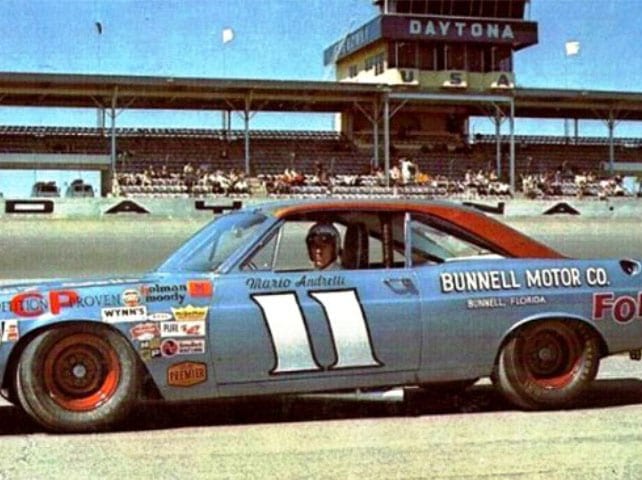
EDITOR’S NOTE: This story was first published in the April 2016 edition of SPEED SPORT Magazine.
Mario Andretti owns one of the finest careers in auto racing history. He’s won the Indianapolis 500, the Formula One world championship, four Indy Car championships and tallied in excess of 100 major victories.
In 1967, however, Andretti was just beginning his climb toward those unprecedented heights of achievement. He was a zealous, determined, sometimes over-his-head competitor, who tended to rub the veterans he was beating routinely in sprint cars and Indy cars the wrong way. The word on Andretti was that he might become a great race car driver — if he lived.
Andretti had established a close relationship with the racing brass at Ford Motor Co. from the time he drove a Ford-powered Brawner Hawk at Indianapolis in 1965. They liked him and the PR he generated for the “Blue Oval.”
Because of those connections when Andretti let Ford know that he wanted to run the 1967 Daytona 500, they put him in the seat of one of the cars at the powerhouse Holman-Moody Racing, Ford’s house team.
At Holman-Moody, Andretti was teamed with Fred Lorenzen. A NASCAR star, Lorenzen had been at Holman-Moody since 1961 and won dozens of races, including the 1965 Daytona 500.
Andretti had only one Daytona 500 start to his credit. He started 37th and finished 39th in Smokey Yunick’s Chevy in 1966. Expecting to call on Lorenzen’s considerable expertise for his 1967 run, Andretti received a rude awakening. Lorenzen and the team were cordial, but not particularly communicative.
“I was like a stranger …” recalled Andretti.
Little wonder. The “good ’ole boys” were not particularly fond of Indy car drivers coming down to play in their sandbox anyway. That Andretti was a cocky “eyetalian,” who received a lot of press only compounded the cold reception.
Still, Andretti was determined to succeed. After a dissatisfying qualifying run, he picked the brains of fellow drivers to understand why the other Fords were quicker than his. The conclusion was that his engine was down at least 400 rpm.
When his complaints to the team were ignored, Andretti went over their heads, directly to Ford officials. He got a fresher engine.
The car came to life and Andretti started turning practice laps faster than pole-winner Curtis Turner. However, because his car had been down on power during qualifying, he had run a lower-angle rear spoiler and was stuck with it for the race.
This made the car extremely loose. What appeared to be an out-of-control driving style during practice, outraged NASCAR regulars. They complained to officials and ranted at the media.
Andretti’s comment: “The car feels good, I’m going to enjoy this.”
He certainly put on a spectacular show.
Running right up against the wall, he wanted to make certain no one got around him on the outside, he called on his experience from the high banks of Winchester, Dayton and Salem speedways to run the corners at 180 mph with the rear end hung out and the right-rear tire smoking. No one else could touch him.
By his final pit stop on lap 163, the 500 appeared to be his. Many of the top runners had fallen out, or were running well off his pace. His closest competition, Lorenzen, was well back in second.
But, the Holman-Moody team had other ideas. When Andretti blasted into the pits, the crew swarmed over his car and serviced it quickly, but failed to drop the jack and release him until Lorenzen had passed him.
“It was absolutely intentional,” Andretti said. “They had orders to hold me and they held me back for about seven seconds.”
Andretti understands the favoritism today. Lorenzen was NASCAR’s Golden Boy. He should win, not Andretti who was running a one-off NASCAR event.
Regardless, Andretti was furious. He slammed the car into gear, tore after Lorenzen and caught him within six laps. Once he passed Lorenzen, he kept charging. Andretti led the last 33 laps of the race. When the yellow flag came out on lap 198, Andretti had a 20-second lead. He cruised to the checkered flag.
It was a hard-fought win for Andretti, both on and off the track. Despite the politics that threatened to stop him, he beat NASCAR’s best — Richard Petty, David Pearson, Cale Yarborough — and a contingent of Indy car drivers that included A.J. Foyt, Gordon Johncock, Jim Hurtubise and Gary Bettenhausen.
It remains today as one of his favorite victories.
